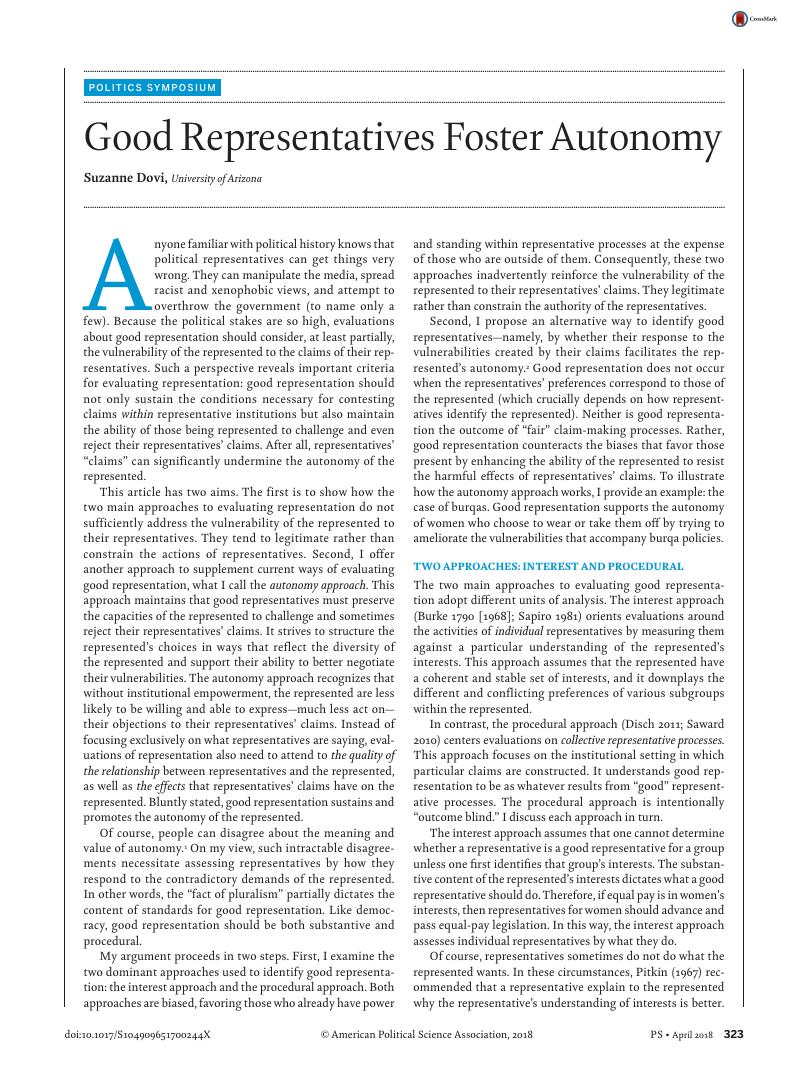No CrossRef data available.
Article contents
Good Representatives Foster Autonomy
Published online by Cambridge University Press: 04 April 2018
Abstract
An abstract is not available for this content so a preview has been provided. Please use the Get access link above for information on how to access this content.

- Type
- Symposium: The Good Representative 2.0
- Information
- Copyright
- Copyright © American Political Science Association 2018
References
REFERENCES
Ben-Porath, Sigal. 2010a. “Exit Rights and Entrance Paths: Accommodating Cultural Diversity in a Liberal Democracy.” Perspectives on Politics 8 (4): 1021–33.Google Scholar
Ben-Porath, Sigal. 2010b. Tough Choices: Structured Paternalism and the Landscape of Choice. Princeton, NJ: Princeton University Press.CrossRefGoogle Scholar
Burke, Edmund. 1790 [1968]. Reflections on the Revolution in France. London: Penguin Books.Google Scholar
Celis, Karen, Childs, Sarah, Kantola, Johanna, and Krook, Mona. 2008. “Rethinking Women’s Substantive Representation.” Representation 44 (2): 99–110.Google Scholar
Christman, John. 2008. “Autonomy in Moral and Political Philosophy.” Stanford Encyclopedia of Philosophy. Stanford, CA: Stanford University.Google Scholar
Disch, Lisa. 2011. “Toward a Mobilization Conception of Democratic Representation.” American Political Science Review 5 (1): 100–114.Google Scholar
Htun, Mala, and Weldon, Laurel. 2010. “When Do Governments Promote Women’s Rights? A Framework for the Comparative Analysis of Sex Equality Policy.” Perspectives on Politics 8 (1): 207–16.Google Scholar
Phillips, Anne. 2004. “Defending Equality of Outcome.” London: LSE Research Online. Available at http://eprints.lse.ac.uk/archive.Google Scholar
Pitkin, Hannah. 1967. The Concept of Representation. Berkeley: University of California Press.CrossRefGoogle Scholar
Sapiro, Virginia. 1981. “Research Frontier Essay: When Are Interests Interesting? The Problem of Political Representation of Women.” American Political Science Review 75 (03): 701–16.Google Scholar
Severs, Eline. 2010. “Representation as Claims Making: Quid Responsiveness?” Representation 46 (4): 411–23.Google Scholar
Strolovitch, Dara. 2008. Affirmative Advocacy: Race, Class, and Gender in Interest Group Politics. Chicago: University of Chicago Press.Google Scholar
Warren, Mark. 2011. “Voting with Your Feet: Exit-Based Empowerment in Democratic Theory.” American Political Science Review 5 (4): 683–701.Google Scholar




